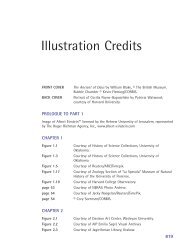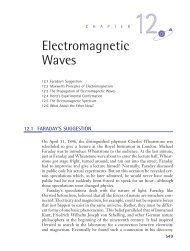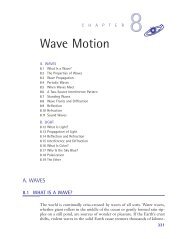Chapter 9: Einstein and Relativity Theory (319 KB) - D Cassidy Books
Chapter 9: Einstein and Relativity Theory (319 KB) - D Cassidy Books
Chapter 9: Einstein and Relativity Theory (319 KB) - D Cassidy Books
You also want an ePaper? Increase the reach of your titles
YUMPU automatically turns print PDFs into web optimized ePapers that Google loves.
3637_<strong>Cassidy</strong>TX_09 6/14/02 12:08 PM Page 423<br />
9.6 RELATIVITY OF TIME 423<br />
Squaring <strong>and</strong> canceling like terms, we<br />
have<br />
c 2 t 2 c 2 t 2 v 2 t 2 .<br />
Now, let’s solve for t:<br />
c 2 t 2 v 2 t 2 c 2 t 2 ,<br />
t 2 (c 2 v 2 ) c 2 t 2 ,<br />
c 2 t 2<br />
t 2 ,<br />
c 2 v 2<br />
t 2<br />
t 2 ,<br />
1 v 2 /c 2<br />
or<br />
t<br />
t ,<br />
1 /c v<br />
2<br />
2<br />
Since 1 v 2 /c 2 is here always less than 1,<br />
the denominator is less than 1, <strong>and</strong> the<br />
fraction is larger than t alone. Thus, the<br />
time interval t registered by the clock as<br />
seen by the stationary observer is “dilated”<br />
compared to the time interval t registered<br />
by the clock as seen by the observer riding<br />
with the clock. In other words, the moving<br />
clock appears to run slower as measured<br />
by the stationary observer than when<br />
the clock is not moving with respect to the<br />
observer. Note also the crucial role of <strong>Einstein</strong>’s<br />
second postulate in this derivation.<br />
Since d is larger than d, t must be larger than t, in order for the ratios on<br />
the right side of both equations to have the same value, c. This means that<br />
the time interval (t) for the round trip of the light pulse, as registered on<br />
the clock as John observes it, is longer than the time interval (t) registered<br />
on the clock as Jane observes it.<br />
The surprising conclusion of this thought experiment (which is really a<br />
deduction from the postulates of relativity theory) is:<br />
Time intervals are not absolute <strong>and</strong> unchanging, but relative. A<br />
clock (such as Jane’s), or any repetitive phenomenon which is moving<br />
relative to a stationary observer appears to the stationary observer<br />
to run slower than it appears to do when measured by the<br />
observer moving with the clock—<strong>and</strong> it appears to run slower the<br />
faster the clock is moving. This is known as time dilation.<br />
Just how much slower does a clock seem when it is moving past an observer<br />
To get the answer, you can use the diagram in Figure 9.10 of John<br />
<strong>and</strong> Jane <strong>and</strong> apply the Pythagorean theorem. After a bit of basic algebra<br />
(see the derivation in the insert), you obtain the exact relationship between<br />
the time elapsed interval registered by a clock that is stationary with respect<br />
to the observer (as in the case of Jane)—call it now T s —<strong>and</strong> the






